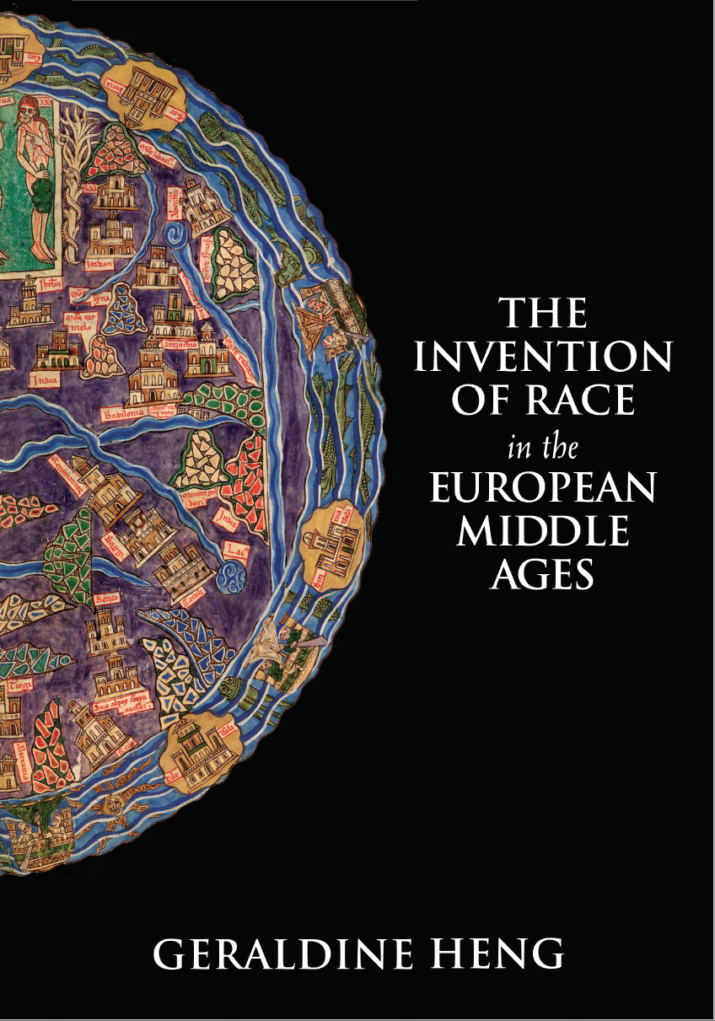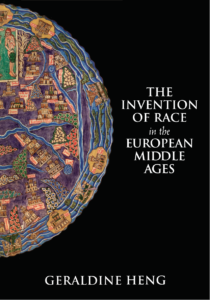
 In the seven years since the publication of Geraldine Heng’s two-part article “The Invention of Race in the European Middle Ages,” the juncture between critical race theory and medieval studies has become livelier and more theoretically sophisticated than ever before. The credit for this vitality, at least in part, must be attributed to those two articles. There, Heng asserts, with urgent clarity, that the vocabulary of race must be retained precisely for “the strategic, epistemological, and political commitments it recognizes” (27). This formulation cogently recognizes several things at once: that medievalists have produced careful studies that attend to questions of race and racism while refusing the term; that charges of anachronism have ensured that certain frameworks are unavailable and certain political commitments irrelevant; and that to insist on the vocabulary of race in an analysis of medieval European archives is to advocate a view of history that accounts for “the transformational grammar” (to borrow Ann Stoler’s term) that allows discourses of race to be both “well-worn” and “innovative.”
In the seven years since the publication of Geraldine Heng’s two-part article “The Invention of Race in the European Middle Ages,” the juncture between critical race theory and medieval studies has become livelier and more theoretically sophisticated than ever before. The credit for this vitality, at least in part, must be attributed to those two articles. There, Heng asserts, with urgent clarity, that the vocabulary of race must be retained precisely for “the strategic, epistemological, and political commitments it recognizes” (27). This formulation cogently recognizes several things at once: that medievalists have produced careful studies that attend to questions of race and racism while refusing the term; that charges of anachronism have ensured that certain frameworks are unavailable and certain political commitments irrelevant; and that to insist on the vocabulary of race in an analysis of medieval European archives is to advocate a view of history that accounts for “the transformational grammar” (to borrow Ann Stoler’s term) that allows discourses of race to be both “well-worn” and “innovative.”
Heng’s follow-up to these articles, The Invention of Race in the European Middle Ages, provides a series of cases studies that demonstrate the flexibility of this central thesis, with chapters functioning as densely textured sketches that articulate the mechanisms of racial logic at several geographically and culturally disparate local sites. The first chapter, “Inventions/Reinventions,” reiterates the theoretical framework of the earlier two-part article, arguing that race must be understood as “a structural relationship for the articulation and management of difference” (19). As in Heng’s previous book Empire of Magic, the archive is largely drawn from the long thirteenth century, which she argues is a period of “intensified collective identity-formation” (31).
A core tenet of Heng’s understanding of race as an analytic is the way its operations transform especially visible individuals into symbolic representatives of an entire [hated, feared, or disavowed] population. In chapter 3, “War/Empire,” she describes this politics of race as “practices of generalization” by means of which “the personality of a singular individual becomes transcoded into the character of a collective totality of peoples” (116). Crucially, that population is then perceived as entirely, impossibly homogenous. This chapter, which deals with the European production of the figure of the Islamic “Saracen,” is dedicated in part to the reversal of such homogenization. Heng zeros in on the legend of the “Old Man of the Mountain” in travel narratives and crusader lore, in which young men are tricked by an old man into believing that his mountain stronghold is the Islamic paradise, replete with gardens and virgins. Having experienced the mountain, the young men are told that they can only return if they assassinate various political enemies of the old man. Heng situates the legend within the context of the Nizaris, breakaway sects of Ismaili Shiites with dispersed, concealed communities in the mountains of Persia and Syria. To Muslim contemporaries, the Nizaris were radical heretics, whose existence signaled the presence of troubling fractures within Muslim orthodoxy. Reading several iterations of the “Old Man of the Mountain” legend, including the versions recorded in Marco Polo and Rustichello da Pisa’s Le Devisement du Monde and in the Travels attributed to Sir John Mandeville, Heng brilliantly argues that in these texts the paradisiacal garden and its assassins are described as Islamic orthodoxy, rendering them symbolically representative of all of “Saracen” culture, and smoothing away internecine conflict within the community. As Heng notes, one of the foremost scholars on the Nizaris is the famous neoconservative Bernard Lewis, who, in the 2002 preface to a new edition of his book The Assassins: a Radical Sect in Islam, claims that the “Assassins may indeed be regarded as the forerunners of the suicide bombers of today.” Heng notes that Lewis is here expressing a desire to find “a genealogy for suicide terrorism” (128), thus reproducing the motivation subtending the Old Man of the Mountain legend: a desire for limpidity that demands and produces the fictions of race.
Marco Polo and Mandeville also feature in chapter 6, “World II,” the lengthiest chapter in the book. “World II” describes Latin Christendom’s varied response to the rise of global Mongol power in the long thirteenth century, beginning with a survey of firsthand accounts of Western diplomats and missionaries such as John of Plano Carpini, William of Rubruck, and John of Monte Corvino, and proceeding to extended close readings of Le Devisment du Monde and Mandeville’s Travels. The first half of the chapter arrives at some exceptionally strong conclusions, particularly with regards to William of Rubruck’s Itinerarium, which Heng argues is inflected by its author’s profound vulnerability, engendering the sort of sharp observation produced in the interest of survival. The second half of the chapter, however, offers little in return for its length. Heng states at the outset that The Invention of Race is intended for a broad audience, whose expertise in the field of medieval studies is not assumed: for most of the book, this results in clear prose and translated source material. However, the readings of Polo and Mandeville recount so much of these texts that they nearly reproduce them, with analysis largely suspended in favor of careful summation. The comments Heng offers on the material, such as her observations about Polo’s taxonomizing tendencies and Mandeville’s nomination of Jews as ultimate difference, are nearly buried under the chapter’s compendious summaries.
Chapter 5, “ World I,” is likewise framed around several long close readings, but Heng’s analysis of the Vinland sagas is nimbler, navigating the line between framing the material for a non-specialist audience and offering a trenchant examination of the sagas as a record of the unequal exchanges that characterize the first European settlement in the Americas. The chapter limits itself to the Greenlanders’ Saga and Eirik the Red’s Saga, and explores the types of interactions that the texts allow for between meeting groups of Icelanders, Greenlanders, and Native Americans.
In a brief preface, titled “Beginnings,” Heng argues that the case studies in her book are not intended as bare bones indicators or “thin descriptions” of “all the territories of racial Europe” but as the “identification of modular instants” (5) of race-making. The importance of this distinction is especially clear in Chapter 4, titled “Color,” which is concerned with blackness, whiteness, and what Heng terms “epidermal race” in the Western European medieval imagination. Describing modular features of medieval race-making differs as a method from sketching the outlines of racial territories primarily in its investment in change over time. This diachronic method tracks strategically deployed rhetorics of universalism, studies how physical features are imagined to index changing truths, and examines the reinscription of past configurations into contemporary racial grids. Heng, reading several romances ranging from the thirteenth to the fourteenth century, argues that while there exists a standard moralizing discourse on color (whiteness indexes piety and blackness sin), romances such as Wolfram von Eschenbach’s Parzival and the Middle Dutch Moriaen do not merely inherit but play with that hermeneutic, using the blackness of one knight to signal his chivalry or attaching the whiteness of another to his treasonous disloyalty. In her reading of the images that represent Saint Maurice as an African knight, Heng argues that Europeans mobilize blackness—crucially, in the absence of black people—to make Christianity global, using race to “recruit Africa for Europe” (234).
Heng places “Color” deliberately in the middle of the book: as she argues throughout, there is no one essential characteristic that indicates race or race-making. To focus exclusively on blackness when considering medieval race is to misunderstand race as a structural organizing force that strategically nominates details as essential. This argument is unmistakably inflected by Heng’s reliance on postcolonial theory. An analysis indebted to different arguments within critical race theory might wish to redefine this central premise, following, for example, the critical framework of thinkers like Alexander Weheliye in black cultural studies to argue that visual bodily markers are indispensable in considering the history of race-making. All such revisionary future scholarship, however, would owe a debt to The Invention of Race for its insistence that this material demands scholarship that is critically informed.
At some points, Heng’s primary intervention is to reorient existing scholarship so that it becomes legible as addressing racializing techne. In the second chapter, “State/Nation,” Heng draws on established scholarship on thirteenth-century English Jews to argue that the mesh of popular hatred, royal protection, and association with capital constitutes Jews as the prototypical racial other of the European Middle Ages. Assessing the “economic panopticon” of lending laws and anti-Jewish legislation like the Statutum de Judeismo of 1275, Heng concludes that in the intensifying desire on the part of the English state to monitor and police its Jewish population we can read an “ethnoracial practice of herding” (69, emphasis in original). This section of the chapter reframes Robert Stacey’s venerable research on the interrelations between anti-Judaism and English economics in the thirteenth century as an investigation into the biopolitics of a state that is both bent on expropriating capital from a marginal population and subject to its own racist logics of escalating anti-Jewish fervor. Stacey concludes that the readiness of Christian taxpayers to foot the bill for Jewish expulsion in 1290 “cannot be explained on strictly economic grounds.” Heng’s careful scaffolding of this insight conveys the logical extremities of a type of racialized redress. Her evocation of the “bioscape” (81) of racialized anti-Judaism accounts for the seeming excess of Stacey’s conclusion, an impulse which escapes description in a framework not attentive to what Heng, in this chapter, deems “race-feeling.”
Similarly, the final chapter, “World III,” places the (much scarcer) scholarship on Romani in premodern Europe in relation to the insights gleaned from critical race theory and developed over the previous chapters. Here, Heng relies primarily on the work of Angus Fraser and Nicolae Gheorghe to investigate Romani methods for navigating a Christian landscape increasingly hostile to them. As a final chapter, “World III” functions partially as a call for attention, bringing an understudied archive under the aegis of Heng’s wide ranging project, and thus insisting on this archive’s continuity with more well-known sites of inquiry. In particular, Heng’s consideration of the “uncanny homologies” (434) between the treatment of Jews and the treatment of Romani deserves further inquiry. Both groups were regularly accused of deicide; both frequently depended on the protection of local nobles or princes; and both were on occasion temporarily “loaned” by monarchs to family members. What can a comparison of Romani serfdom in Moldavia and Henry III’s leasing of Jews to his brother Richard Earl of Cornwall in England tell us about the conditions of dependency for each marginalized group?
This sort of question, in its basic premise, might irritate some scholars, on strictly historicist grounds. Such irritation, however, arises not from a critique of concepts but from a politics of knowledge that volleys accusations of anachronism and derides comparative critique on the basis of supposedly inviolate categories of analysis. As Ania Loomba has observed in “Race and the Possibilities of Comparative Critique,” a cautious comparativism can not only make visible histories of difference and discrimination, but can “allow us to push at the limits of our understanding of the very grounds of cultural comparison and of knowledge production” (518). The Invention of Race in the European Middle Ages evinces the careful comparative work in the service of clear anti-racist political commitments that Loomba and others have long called for.
Reviewed by Shoshana Adler, University of Pennsylvania
The Invention of Race in the European Middle Ages
By Geraldine Heng
Publisher: Cambridge University Press
Hardcover / 504 pages / 2018
ISBN: 978-1108422789
To read more book reviews click here.
Published on October 2, 2018.
References:
Heng, Geraldine. “The Invention of Race in the European Middle Ages I: Race Studies, Modernity, and the Middle Ages,” and “The Invention of Race in the European Middle Ages II: Locations of Medieval Race,” Literature Compass 8.5 (2011): 315-50.
———-. The Invention of Race in the European Middle Ages. Cambridge, UK: Cambridge University Press, 2018.
Loomba, Ania. “Race and the Possibilities of Comparative Critique.” New Literary History 40.3 (2009): 501-22.




